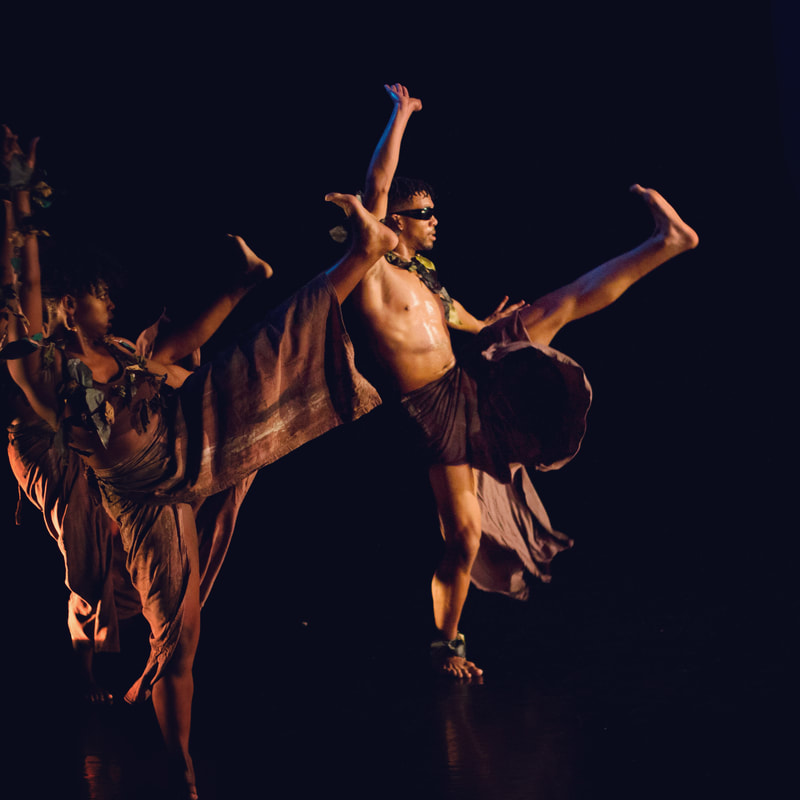|
Umfundalai is a contemporary African dance technique that comprises its movement vocabulary from dance traditions throughout the Diaspora. The literal word, Umfundalai, means “essential” in Kiswahili. Much like the late Katherine Dunham, Kariamu Welsh, Umfundalai’s progenitor, has designed a stylized movement practice that seeks to articulate an essence of African – oriented movement or as she describes, “an approach to movement that is wholistic, body centric and organic.” - umfundalai.net Julian has been working in the style of Umfundalai for about 9 years. He says that Umfundalai began as a dream for black women to have a space to “have a space to express their stories, learn more about their bodies and utilize them as an instrument of creation,” (it wasn’t until the mid 1990s we began to see more men participating in the style). Umfundalai is an explorative style- it asks “what can you do with your body? How many different ways can you access different types of movement? How can you express different concepts with the information your body has to offer?” The style centers on arriving where you are and expressing who you are in the moment while constantly learning and adding more information, knowledge and skills. The fact that everyone will look different performing, studying and creating work within the Umfundalai technique is welcomed and encouraged. I spoke with Julian to find out a little bit more about his relationship to Umfundalai and what we can expect from his workshop! Check it out: How did you get into studying Umfundalai?
I have been working in this style for 9 years. I remember one of my friends from Temple University asked me ‘what are you doing on Saturday morning?’ and I said…sleeping?’ and she said ‘no you’ll be in Studio 221 at 10am’ and walked away. It seemed pretty urgent so I showed up and it was the beginning of a life changing experience. Can you talk a little more about why you consider your relationship with Umfundalai life changing? It has been life changing for 2 reasons. 1) It has helped me work through mental health issues, body image issues, and confidence issues because it really focuses on living and existing unapologetically. Maybe you feel like your body isn’t moving the way that you want it to in a particular moment- that's ok! Thats who you are today. How can you work with and work through what is ailing you and still be able to stand on your own two feet-- or maybe you even sit on a chair that day! The focus is on how can you still be physically present and aware and appreciative of the body that you are in. And 2) On a more performative level- I have been able to tour different states of the country- I have been able to leave the country and perform in Jamaica for 3 years in a row. Having a dance family outside of the country is something I am so grateful for. It's about connectivity- its not always about movement. Sometimes there has to be a conversation-- Umfundalai gets at the idea that the physical body and the psychological body overlap What is the structure of the class typically like? We would typically start with something called nanigo. Nanigo is comprised of 2 concentric circles that give everyone the opportunity to see everyone else in the room and affirm them as they are in that moment. From nanigo we would typically move to center to and then we would move across the floor (sometimes this order is changed depending on the instructor and needs of the participants.) And then if the goal of the class is a movement phrase then you can work on that. What are some of your personal goals in dance? In my teaching practice I am interested in finding the balance between what different students are after and what I want to communicate with them. Some students will just show up with the attitude of- ‘I’m expecting you to kick my butt today and then we’re going to do this amazing combo to end and I’m going to put my phone down to record myself and then it’s going on social media.’ And that’s fine but -there's more we can do. We are expected to be cookie cutters. There is often an expectation that if one person could do something then everyone else should be able to. But not everybody is the same. One of my biggest goals in dance is to help people find themselves- whatever that might mean. Comments are closed.
|
ContributorsKayla Bobalek Archives
May 2024
Categories |
Locations
812 Chestnut StSearch 'Urban Movement Arts @ 812 Chestnut' on Google Maps
|
2100 Chestnut St. 2nd Flr
*entrance is on 21st! between Rione Pizza & Monde Market*
|


 RSS Feed
RSS Feed